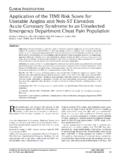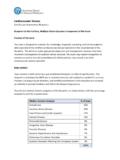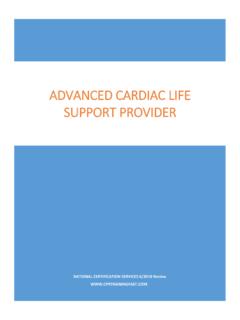Transcription of ACC/AHA Guideline - CCCVI
1 ACC/AHA /ASNC guidelines for the Clinical Use of CardiacRadionuclide Imaging Executive SummaryA Report of the American College of Cardiology/American HeartAssociation Task Force on Practice guidelines ( ACC/AHA /ASNC Committee to Revise the 1995 Guidelinesfor the Clinical Use of Cardiac Radionuclide Imaging)Committee MembersFrancis J. Klocke, MD, MACC, FAHA, Chair;Michael G. Baird, MD, FACC, FAHA; Beverly H. Lorell, MD, FACC, FAHA;Timothy M. Bateman, MD, FACC, FAHA; Joseph V. Messer, MD, MACC, FAHA;Daniel S. Berman, MD, FACC, FAHA; Patrick T. O Gara, MD, FACC;Blase A. Carabello, MD, FACC, FAHA; Richard O. Russell, Jr, MD, FACC;Manuel D. Cerqueira, MD, FACC, FAHA; Martin G. St. John Sutton, MBBS, FACC;Anthony N.
2 DeMaria, MD, MACC, FAHA; James E. Udelson, MD, FACC;J. Ward Kennedy, MD, MACC, FAHA; Mario S. Verani, MD, FACC*;Kim Allan Williams, MD, FACC, FAHATask Force MembersElliott M. Antman, MD, FACC, FAHA, Chair; Sidney C. Smith, Jr, MD, FACC, FAHA, Vice-Chair;Joseph S. Alpert, MD, FACC; Gabriel Gregoratos, MD, FACC, FAHA;Jeffrey L. Anderson, MD, FACC; Loren F. Hiratzka, MD, FACC, FAHA;David P. Faxon, MD, FACC, FAHA; Sharon Ann Hunt, MD, FACC, FAHA;Valentin Fuster, MD, PhD, FACC, FAHA; Alice K. Jacobs, MD, FACC, FAHA;Raymond J. Gibbons, MD, FACC, FAHA ; Richard O. Russell, MD, FACC Table of ContentsI. 1405II. Acute 1406A. Myocardial Perfusion Imaging in the Assessmentof Patients Presenting With Chest Pain to theEmergency Department.
3 1406B. Detection of AMI When Conventional MeasuresAre 1406C. Radionuclide Testing in Risk Assessment: Prognosisand Assessment of Therapy After STEMI .. 1406D. Radionuclide Testing in Risk Assessment: Prognosisand Assessment of Therapy After NSTEMI or UA. 1406 III. Chronic Syndromes .. 1407 The ACC/AHA Task Force on Practice guidelines makes every effort to avoid any actual or potential conflicts of interest that might arise as a resultof an outside relationship or personal interest of a member of the writing panel. Specifically, all members of the writing panel are asked to providedisclosure statements of all such relationships that might be perceived as real or potential conflicts of interest. These statements are reviewed by the parenttask force, reported orally to all members of the writing panel at the first meeting, and updated as changes document was approved by the American College of Cardiology Foundation Board of Trustees in July, 2003, the American Heart AssociationScience Advisory and Coordinating Committee in July, 2003, and the American Society of Nuclear Cardiology Board of Directors in July, citing this document, the American College of Cardiology Foundation, the American Heart Association, and the American Society of NuclearCardiology request that the following citation format be used.
4 Klocke FJ, Baird MG, Bateman TM, Berman DS, Carabello BA, Cerqueira MD, DeMariaAN, Kennedy JW, Lorell BH, Messer JV, O Gara PT, Russell RO Jr, St. John Sutton MG, Udelson JE, Verani MS, Williams KA. ACC/AHA /ASNC guidelines for the clinical use of cardiac radionuclide imaging executive summary: a report of the American College of Cardiology/American HeartAssociation Task Force on Practice guidelines ( ACC/AHA /ASNC Committee to Revise the 1995 guidelines for the Clinical Use of RadionuclideImaging). (Circulation. 2003;108:1404 1418.)*Deceased. Former Task Force Member. Former Task Force Chair.(Circulation2003;108:1404-1418.) 2003 by the American College of Cardiology Foundation and the American Heart Association, available at : Guideline by guest on May 16, 2016 from A.
5 Detection (Diagnosis) of 14071. Sensitivity and 14072. Effect of Referral Bias .. 14073. Quantitative Analysis .. 14084. ECG-Gated SPECT .. 14085. Attenuation Correction .. 14086. Positron Emission 1408B. Management of Patients With Known orSuspected Chronic CAD: Assessment of DiseaseSeverity, Risk Stratification, Prognosis .. 14081. Nongated Myocardial Perfusion 14082. Gated 14083. Radionuclide 14084. Cost Effectiveness .. 14085. Frequency of 14086. Evaluation of the Effects of Medical 1408C. Specific Patient 14081. African 14082. 14083. Normal Resting ECG, Able to 14094. Intermediate-Risk Duke Treadmill 14095. Normal Resting ECG, Unable to Exercise. 14096. 14097. Left Ventricular 14098.
6 Patients With Nonspecific 14099. 140910. Asymptomatic 140911. Obese 140912. 140913. After Coronary Calcium Screening .. 141014. Before and After 141015. Radionuclide Imaging Before 1410D. 1410IV. Heart 1412A. 1412B. Assessment of LV 14131. Assessment of LV Systolic 14132. Assessment of LV Diastolic Dysfunction . 1413C. Assessment of CAD .. 14131. Importance of Detecting CAD in HeartFailure Patients .. 14132. Myocardial Perfusion Imaging to Detect CADin Heart Failure 1413D. Assessment of Myocardial 14131. Goals of Assessing Myocardial 14132. General Principles of Assessing MyocardialViability by Radionuclide 14143. Techniques and Protocols for AssessingMyocardial 14144.
7 Image Interpretation for MyocardialViability: Quantitative Versus VisualAnalysis of Tracer Activities .. 14145. Comparison of 1414E. Etiologies of Heart 14151. Dilated 14152. Dilated Cardiomyopathy Due toDoxorubicin/Anthracycline Cardiotoxicity. 14153. Dilated Cardiomyopathy Due toMyocarditis .. 14154. Posttransplantation Rejection and 14155. Chagas Myocarditis and/or Sarcoid Heart Disease .. 14167. Cardiac Amyloidosis .. 14168. RV 14169. Hypertrophic 141610. Hypertensive Heart Disease .. 141611. Valvular Heart 141612. Adults With Congenital Heart 1417I. IntroductionThe American College of Cardiology (ACC)/American HeartAssociation (AHA) Task Force on Practice guidelines regularlyreviews existing guidelines to determine when an update or fullrevision is needed.
8 guidelines for the Clinical Use of CardiacRadionuclide Imaging were originally published in 1986 andupdated in 1995. Important new developments have continued tooccur since 1995, particularly in the areas of acute and chronicischemic syndromes and heart failure. The Task Force thereforebelieved the topic should be revisited de novo and invited theAmerican Society for Nuclear Cardiology (ASNC) to cosponsor theundertaking, which represents a joint effort of the 3 full-text Guideline is available on the Internet ( , , and ). It discusses the use-fulness of nuclear cardiological techniques in 3 broad areas: acuteischemic syndromes, chronic syndromes, and heart failure. Utility isconsidered for diagnosis, severity of disease/risk assessment/prog-nosis, and assessment of therapy.
9 An appendix provides descrip-tions of individual techniques. This Executive Summary includesrecommended indications for the use of specific techniques andsummary evaluations of topics addressed in the full-text supporting evidence and a complete reference list arepresented in the full-text current Guideline overlaps with several previouslypublished ACC/AHA guidelines for patient treatment thatpotentially involve cardiac radionuclide imaging. These in-clude published guidelines for chronic stable angina (SA;2002), unstable angina and non ST-elevation myocardialinfarction (UA/NSTEMI; 2002), heart failure (2001), periop-erative cardiovascular evaluation for noncardiac surgery(2002), exercise testing (2002), valvular heart disease (1998),and acute myocardial infarction (AMI; 1999).
10 The presentreport is not intended to include information previouslycovered in these guidelines or to provide a comprehensivetreatment of the topics addressed in these ACC/AHA classifications I, II, and III are used tosummarize indications as follows:Class I: Conditions for which there is evidence and/orgeneral agreement that a given procedure ortreatment is useful and effectiveClass II: Conditions for which there is conflicting evi-dence and/or a divergence of opinion about theusefulness/efficacy of a procedure or treatmentKlocke et al ACC/AHA guidelines for Cardiac Radionuclide Imaging1405 by guest on May 16, 2016 from IIa: Weight of evidence/opinion is in favor ofusefulness/efficacyIIb: Usefulness/efficacy is less well established byevidence/opinionClass III: Conditions for which there is evidence and/orgeneral agreement that the procedure/treat-ment is not useful/effective and in some casesmay be harmfulLevels of evidence for individual class assignments aredesignated as follows:A: Data derived from multiple randomized clinical trialsB: Data derived from a single randomized trial or fromnonrandomized studiesC: Consensus opinion of expertsThese guidelines will be reviewed annually by the TaskForce and will be considered current unless the Task Forcerevises or withdraws them from Acute SyndromesA.







